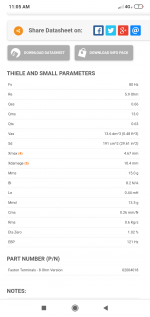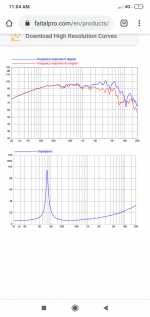Hey guys...
My initial plan is to build a two way ported BS with Faitalpro 8FE200 + Faitalpro HF100 compression driver.
Before building I'm curious to know what is the best suitable enclosure for 8FE200.
Sealed??
Ported??
Transmission line ??
Open Baffle ???
Theoretically it is suitable for ported, based on the thumbrule of EPB=FS/QES
but seeking expert advise based on practical experience.
I can simulate sealed and ported responce in winisd etc. FS of the driver is 80 hz, so bass assistance is needed in both sealed and ported box.
But anybody used it in TL or Open baffle ????
Is there any advantage in building a TL compared to ported ???
My initial plan is to build a two way ported BS with Faitalpro 8FE200 + Faitalpro HF100 compression driver.
Before building I'm curious to know what is the best suitable enclosure for 8FE200.
Sealed??
Ported??
Transmission line ??
Open Baffle ???
Theoretically it is suitable for ported, based on the thumbrule of EPB=FS/QES
but seeking expert advise based on practical experience.
I can simulate sealed and ported responce in winisd etc. FS of the driver is 80 hz, so bass assistance is needed in both sealed and ported box.
But anybody used it in TL or Open baffle ????
Is there any advantage in building a TL compared to ported ???
With a 0.44 Qt and small Vas it will need a big/long vent to efficiently tune a reflex, so morph the box/vent into a MLTL or inverse tapered TQWT for better damping, maybe a bit easier build depending on its configuration.
GM
GM
Please see the attached TS parameters
Greets!
You're welcome!
OK, when I searched, Google gave me the 4 ohm, but only looked at the Vas, Qts spec.
Doesn't matter though, my recommendation is still the same. 😉
GM
please see the basic simulation graph attached.
Pink graph:
12L sealed box.
F3 = 117hz
F6 = 90hz
Green graph:
20L PORTED box.
Box tuning = 65hz
F3=64hz
F6=55hz
(there is a peak which has to be flattened further-im trying)
I know simulation doesn't exactly replicate real life performance.
I have to learn how to calculate MLTL and TQWT. I will work on it.
But meanwhile, based on your experience, what can be the advantage with MLTL or TQWT compared to sealed or ported. Any suggestion please ....
Pink graph:
12L sealed box.
F3 = 117hz
F6 = 90hz
Green graph:
20L PORTED box.
Box tuning = 65hz
F3=64hz
F6=55hz
(there is a peak which has to be flattened further-im trying)
I know simulation doesn't exactly replicate real life performance.
I have to learn how to calculate MLTL and TQWT. I will work on it.
But meanwhile, based on your experience, what can be the advantage with MLTL or TQWT compared to sealed or ported. Any suggestion please ....
Attachments
You have to see if a standard port is feasible for your design. The port air velocity is very important. Model the port at your desired power use and see the speed. Speeds over 30 are bad since they generate chafing aka bad port noise. About 15 are good. So you model your port and tune and power: that will tell you the diameter, length and number of ports required for your goals. Doubling the ports halves the speed but each port will be twice as long. Sometimes a port for the desired power output and speed cannot be physically built on the cabinet. At such time look for other type of box architecture.
- Home
- Loudspeakers
- Multi-Way
- What's the best suitable enclosure for Faitalpro 8FE200


